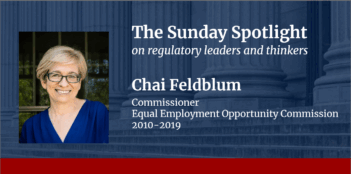
EEOC proposal raises questions about pay equity—and privacy.
When an anonymous group reportedly hacked into Sony Pictures’ servers, an email surfaced revealing that the studio paid celebrities Jennifer Lawrence and Amy Adams less than their male co-stars for the movie American Hustle.
This is but one prominent example of a gender pay gap that extends beyond Hollywood. Whether working as actors, teachers, or engineers, women from all walks of life report receiving lower pay than their male co-workers. Over the past four years, over 4,000 individuals filed charges with the U.S. Equal Employment Opportunity Commission (EEOC) for violations of the Equal Pay Act. The Act requires employers to provide equal compensation to women and men for the same work.
Now, a recent proposal from the EEOC aims to address this problem by requiring employers to submit data on employees’ earnings by sex. However, the proposal will likely face criticism for adding to businesses’ paperwork burdens and potentially compromising confidential pay information.
The proposal would revise an annual report that employers already must send to the EEOC with information on their employees. Employers would, beginning in September 2017, be expected to indicate the number of male and female employees in twelve different salary ranges. Only large private employers and federal contractors with 100 or more employees would have to submit salary data. The data would be organized by job category, which would enable the EEOC to identify salary disparities between male and female employees with comparable job titles.
“More than fifty years after pay discrimination became illegal it remains a persistent problem for too many Americans,” said EEOC Chair Jenny R. Yang. “Collecting pay data…will assist employers in evaluating their pay practices to prevent pay discrimination and strengthen enforcement of our federal anti-discrimination laws.”
When explaining this gap, the Obama Administration points to the possibility of discriminatory pay practices. In conjunction with the EEOC proposal, the White House released a report comparing median wages for full-time male and female workers from different labor categories. It found that overall, female workers’ earnings amount on average to seventy-nine percent of what male workers earn.
But some scholars say the pay gap arises from other factors, like women pursuing less lucrative occupations. For example, Christina Hoff Sommers, resident scholar at the think tank American Enterprise Institute, claims that the wage gap almost vanishes after adjusting for disparities in occupation, education, experience, and number of hours worked each week.
The EEOC proposed data collection form might help in determining how important at least some of these other factors are, as it would call for employers to indicate hours worked when reporting employees’ salary data.
Sommers further states that among the top ten most lucrative college majors, overall there are more men than women. She suggests that the gender wage gap might be more of a reflection of gender-based vocational preferences, rather than employers’ pay practices.
The recent White House report acknowledges that occupation and industry differences could lead to pay disparities between men and women. However, it also notes that women may choose to enter certain professions due to discrimination that exists in other professions.
In another recent report, Francine Blau and Lawrence Kahn, Professors of Economics at Cornell University, explore how factors like occupation contribute to the gender wage gap. They found that differences in occupation and industry explain a little over half of the pay gap between men and women in the United States, making them the most significant contributors to pay disparities.
On the other hand, the combined effect of education and work experience account for less than ten percent of the gender wage gap, say Blau and Kahn. Women are now actually more educated on average than men and more likely to earn graduate degrees. Women also made substantial gains in work experience. In 1981, men had almost seven more years of full-time experience compared with women. By 2011, this disparity in work experience had fallen by over five years.
But even after controlling for a range of factors affecting the wage gap, whether occupation or experience, thirty-eight percent of the pay gap remains unexplained, according to Blau and Kahn. This unexplained disparity may point to discrimination in the workplace, but presumably more data would help in clarifying the extent of any discrimination. That points to the rationale behind the EEOC’s recent proposal for submission of salary data.
Yet some businesses are not happy about this possible new reporting tool. Greg Keating, chair of the labor, employment and benefits practice at the law firm Choate Hall & Stewart LLP, argues that many employers will face significant burdens in complying with what the EEOC has proposed. Some may not even have a system in place to collect and submit salary information as part of their EEOC reports.
“It’s not a simple exercise by any means,” Keating has reportedly said. “It’ll take a lot of manpower and [information technology] resources, [and] could potentially be a massive intrusion into how employers conduct business.”
But other attorneys claim the reporting requirement would not demand a lot of additional paperwork. Katherine Kimpel at Sanford Heisler Kimpel LLP asserted that most large employers already maintain a system with employee data and could just add an additional entry for employee salary.
Although pay data would be reported to the EEOC in an aggregate form to protect employee confidentiality, attorneys have also raised issues about data breaches, citing the U.S. Office of Personnel Management hack from last year that apparently involved approximately 21.5 million individuals. If an employer has a small number of employees in a particular job category, it could be easy to estimate employees’ individual salaries after a breach.
Ballard Spahr partner Shannon Farmer noted that privacy concerns may prove particularly worrisome for private companies without stockholders, since their information would allegedly be “competitively valuable” to competitors.
Other employment law attorneys said that the EEOC proposal sends the signal the Obama Administration is poised to take action against suspect pay practices.
“Employers would have to have their head in the sand to not realize that pay discrimination is a priority for this administration,” Leigh Nason, shareholder and compliance attorney at Ogletree Deakins, reportedly stated. “It would be prudent for employers to recognize that they should get their house in order—and quickly.”
The comment period for the proposed revision closed on April 1, 2016.



